Apple's iPhone 4: Thoroughly Reviewed
by Brian Klug & Anand Lal Shimpi on June 30, 2010 4:06 AM EST- Posted in
- Smartphones
- Apple
- iPhone 4
- Gadgets
- Mobile
Performance
When the 4 was announced, my curiosity (and perhaps yours as well?) was about the flavor of Apple’s A4 SoC inside the phone. The rumor was that the A4 in the iPhone 4 had a full 512MB of memory, compared to 256MB in the iPad’s A4. iFixit took an iPhone 4 apart (with relative ease I might add) and confirmed the presence of 512MB. Look at the A4 in this picture, the Samsung part number on the right edge of the chip starts out K4X4G. The K4X denotes a Samsung mobile DRAM and the 4G refers to its density: 4Gbit or 512MB.
More memory should mean a smoother multitasking experience on the iPhone 4. Remember that iOS 4 keeps all fast task switching enabled apps resident in memory even after you’ve switched away from them. They are only kicked out of memory if you run low or if you force quit them. With more memory you should be able to keep more apps in memory without unwillingly forcing them out. The 512MB of RAM should also give the OS more breathing room in lighter multitasking scenarios, a problem many are already seeing on the iPhone 3GS running iOS 4. In practice the 4 is smoother when running iOS 4. There are still some hiccups but not as bad as on the 3GS, and definitely not as bad as on the 3G. The OS was clearly designed with the iPhone 4 as the performance target.
The big question that remains is what clock speed the iPhone 4’s A4 is running at. The assumption was 1GHz however Apple was very careful not to mention clock speed, unlike at the iPad launch. Saying nothing usually means there’s nothing good to say.
I ran a whole bunch of benchmarks on the iPhone 4 and the iPhone 3GS running iOS 4 to try and figure out what CPU speed we might be dealing with. The early reviews imply that the A4 in the iPhone 4 is running at a speed greater than the 3GS’s 600MHz, but slower than the iPad’s 1GHz. Let’s try and find out what it’s really running at.
We’ll start with the real world tests, first SunSpider. A javascript performance test this benchmark is completely network independent but it measures the performance of the browser as well as the underlying hardware. It is small enough to make memory size differences negligible so between the two iPhones we should be seeing a pure CPU comparison:
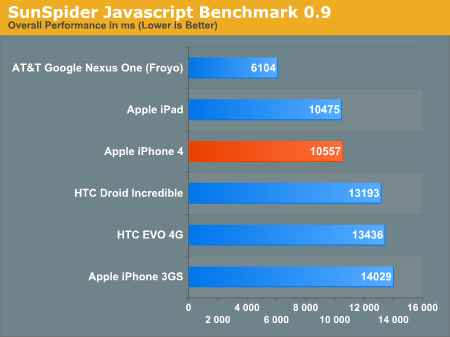
The iPhone 4 manages a time that’s 25% faster. Note that this test is just as much about the software stack as it is about CPU/platform performance. The Froyo update makes the Nexus One ridiculously fast in this benchmark. It just shows you how much room there is to improve performance on these Android handsets. The next leapfrog is going to be once the entire Android world moves to 2.2.
Next up is the Rightware BrowserMark. This test combines JavaScript and HTML rendering performance:
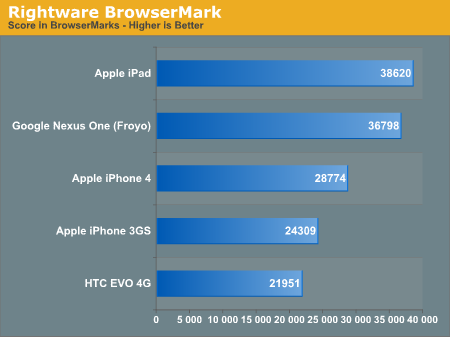
BrowserMark spits out an overall score but with no indication of what the score actually means. In this case we’re looking at 18.4% better performance than the iPhone 3GS. The iPad is 34% faster than the 4, which supports the theory of the A4 running at ~750MHz in the new iPhone.
There's also the possibility that the A4 CPU clock varies depending on load and other factors but the run to run consistency in all of our tests seems to indicate otherwise. We also can't ignore the fact that the iPad and iPhone now run vastly different OS revisions. In some cases iOS 4 actually takes a step back in performance compared to iOS 3.2. That undoubtedly makes the iPad vs. iPhone 4 comparison about much more than CPU performance.
Froyo's improved Javascript performance sends the Nexus One nearly to the top of the list here, only bested by the iPad. While Apple has definitely improved performance with the iPhone 4, it seems that it will only take a software update for Android phones to surpass it.
To measure web browsing performance I downloaded a bunch of different web pages and saved as much of them as possible locally on a server. I used WiFi on all of the devices to connect to my local server and timed average load time. I repeated the test at least 3 times and threw out any unusually high or low numbers. Performance was from a clean restart with no additional programs running in memory.
Note that these numbers aren't comparable to other reviews as we've updated software versions on two of the phones. The iPhone 3GS is now running iOS 4 which resulted in some numbers going up while others went down. And the Google Nexus One is running the officially released build of Android 2.2, codenamed Froyo.
What these tests should show is the overall performance of the platform when all network bottlenecks are removed. Obviously hiding in a tunnel under a lead umbrella will make any phone slow, but we’re looking at peak performance here.
The first test is the new AnandTech front page. Here we’ve got tons of images and HTML, meaning we’re stressing both bandwidth and code parsing speed.
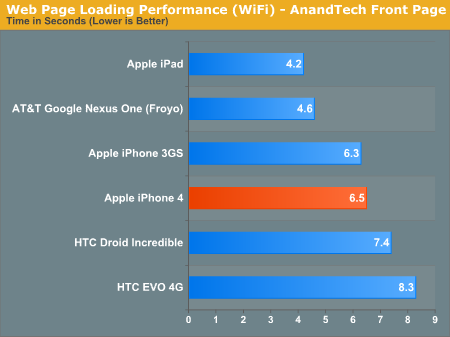
The iPhone 4 is no faster than the 3GS (actually slightly slower, but we'll chalk that up to timing variance) here. The Froyo update to the Nexus One makes it lightning quick, almost as fast as the iPad in our first test.
Next up we have the first page of our recent Zotac XBOX HD-ID11 review. The balance shifts from tons of images to more HTML processing:
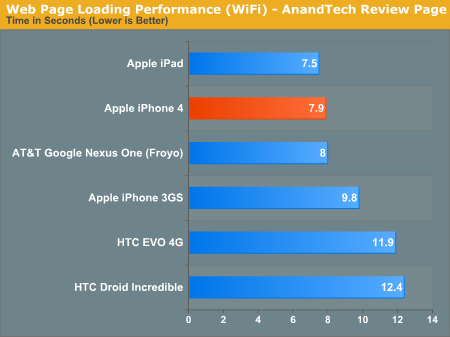
Here we see more of what I expected: the iPhone 4 is around 25% faster than the 3GS running iOS 4. Android 2.2 running on the Nexus One is basically as fast as the 4.
Using our Print this Review function, this next test loads our entire 2010 15-inch Macbook Pro review. While the other two tests had some flash ad content, this one is completely devoid of it so the HTC phones shouldn’t be penalized:
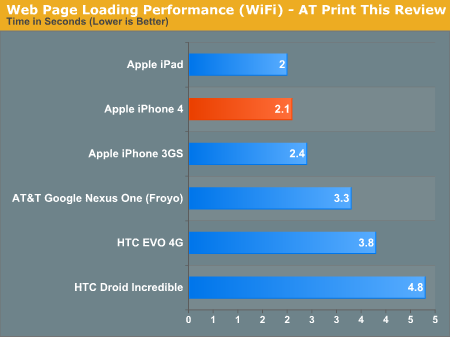
Here the iPhone 4 is 11% faster than the 3GS and about the speed of the iPad. There are other bottlenecks at play here so we don't get further performance scaling. The Froyo update helps the Nexus One a bit but the iOS devices are still quicker.
Our most intensive test is up next with a load of the Engadget front page:

The Nexus One is ahead of the 4 once more with its Froyo update. And the iPhone 4 is 34% faster than the 3GS.
Our most CPU bound test is up next. I put together a custom page with a ton of tabular content and a single page copy of our 15-inch MBP review to make the load take some time at least.
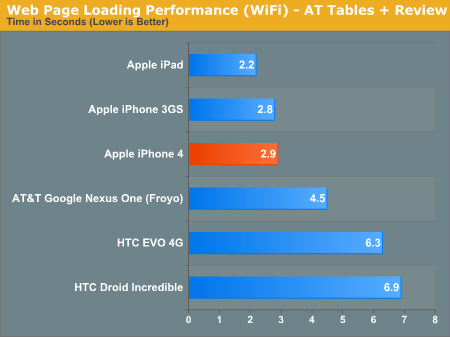
Surprisingly enough there's no difference between the 3GS and the 4 here, perhaps my test is less CPU bound than I thought. Froyo improves the Nexus One's performance a little bit.
Low Level Synthetic Tests
If we assume that we’re mostly CPU bound in all of these cases (a fair assumption given how fast Atom can run through all of these tests), then we’d be looking at a ~750MHz clock speed for the iPhone 4’s A4 assuming no other architectural changes. That’s actually a pretty big assumption. The A4 is widely believed to be a 45nm SoC using an ARM Cortex A8. At 45nm there should be room for a larger L2 cache than what was used in the iPhone 3GS’s SoC.
Perhaps some more synthetic tests will help us figure out what’s going on. I turned to Geekbench, now available in an iOS version.
Geekbench spit out a number of overall results that gave me a good enough summary of what’s going on to make an educated guess:
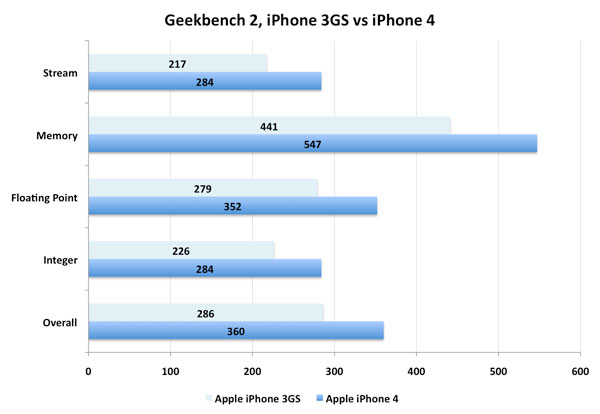
The CPU specific tests all indicate the iPhone 4 is around 25% faster than the iPhone 3GS. That would imply at least a 750MHz clock speed if all else is the same. Assuming we don’t get perfect CPU scaling with all of these tests, I’d venture a guess that 800MHz is more accurate. If the A4 does indeed have larger caches however, Apple could get away with a lower clock speed.
The memory results are particularly telling as they all scale very well going to the iPhone 4, better than the CPU results in fact. This could lend credibility to the theory of larger internal caches or perhaps to an improved (faster) memory subsystem.
Unfortunately until we get the iPad on iOS 4 we can't get a better idea of CPU scaling. I'm not even sure how reliable that will be at this point. If Apple was willing to change the amount of memory the A4 package housed between the iPad and iPhone 4, who is to say that it wouldn't have a slightly different design for the iPhone 4 (e.g. larger caches). The designs may not be physically different but we may instead be looking at binning. Given Apple's unwillingness to talk about the architecture here I think the safest bet is that we're looking at an 800MHz ARM Cortex A8 core in the iPhone 4 and a 1GHz core in the iPad.
Why the lower clock? It's all about battery life.










270 Comments
View All Comments
strikeback03 - Tuesday, July 6, 2010 - link
How does international work? Are other parts of Europe covered by that as well or are they all additional?B3an - Thursday, July 1, 2010 - link
Theres way WAY less options for network and internet providers in the U.S, especially compared to here in the U.K..So less competition means higher prices. And of course the size of the U.S/Canada is a problem.
strikeback03 - Thursday, July 1, 2010 - link
Some friends who have been living in England say that cell usage over there is way more expensive. They claim the only affordable way to do it is with pay as you go SIMs and just not use them much.But yes more competition would be nice. For me Verizon is the only carrier that offers the kind of coverage I need. So between the fact that I can't go anywhere and that they don't offer an off-contract rate I have no reason not to take the subsidized phones and contract extensions.
Chissel - Sunday, July 4, 2010 - link
I'm an American living in the UK. iPhone 4 rates here are much lower. The best I have seen is from Tesco (o2 network). Low cost no frills service. 750 minutes + unlimited texts + 1gb of data per month. Also, incoming calls do not charge minutes. 1 yr. contract 32gb iPhone 4 = £299/$450 + £35/$50 per month (all tax included). After 1 yr. they have to unlock your phone. After you unlock the phone you can drop down to £20/$30 per month.This means the 2 year cost of the phone + service in the UK is £959/$1,438. In the US the 2 year cost is $299 + tax and $105/mo + tax. Total cost over 2 years is $2,819 without tax.
As you can see the UK has much lower price over the 2 years. Plus, after 1 year you 'own' your phone and can resell and buy iPhone 5.
strikeback03 - Tuesday, July 6, 2010 - link
I think the unlock on AT&T can be requested after 3 months, definitely after a year as I had a friend do that.StormyParis - Saturday, July 3, 2010 - link
I've abandonned data plans, and switched back to plain voice, on my HD2. I get Wifi most everywhere (at home and at work for sure, and most places in between). I was simply not using data that much, it's not worth the monthly 30 euros they want for it.99.5% of the time, there's no difference at all. 0.5% of the time... i can survive...
vol7ron - Wednesday, June 30, 2010 - link
I agree, but..."The fact that Apple didn't have the foresight to coat the stainless steel antenna band with even a fraction of an ounce worth of non-conductive material either tells us that Apple doesn't care or that it simply doesn't test thoroughly enough. The latter is a message we've seen a few times before with OS X issues..."
Apple would just see this as another selling point for the bumper.
Anand/Brian-
I'm curious if you've had a chance to test with the microfilm covers like Bodyguardz or Zagg.
I use these because of how thin they are and how great they are at protecting the device (scratch free even when dropping on concrete). They cover all points of the phone rather effectively. I'm curious if they would be beneficial to your testing.
vol7ron
Brian Klug - Wednesday, June 30, 2010 - link
vol7ron,You're totally right, I need to test with a thin film or some heavy duty tape/invisible shield. I originally thought of doing that, but somehow it got lost in all that frenzied testing. I'll whip something up and see if anything changes. I mean that's a good point too, it might not do very much.
I mean, ultimately there's a thickness you do need to achieve, and to be fair a lot of the benefit the case adds is that extra couple mm or two from the antenna. If the film is too thin, it might not do much. What makes me uneasy about saying anything definitively is that this is so near field - literally on top of the radiative surface. I'll admit I have only a basic level of understanding about what kind of interference happens in the very near field. I mean even at 1.8 GHz, one wavelength is 16 cm - the case and your hands on the phone is way inside near field.
-Brian
rainydays - Wednesday, June 30, 2010 - link
Agree. Outstanding review. The detailed analysis and level headed tone is excellent. Keep up the great work.Antenna section was illuminating. Good point about using SNR. I wonder if that number by itself is sufficient though. I guess signal power in dbm along with SNR would give the most complete picture of reception.
At any rate, as is abundantly clear in the article, you never really know where you are till you see the numbers.
John Sawyer - Thursday, July 1, 2010 - link
Yes, the numbers, details, etc. are more important than a lot of people realize. It often annoys me when I see people commenting about issues that involve actual measurement, technical facts, etc., without referring to any of those, and thus winding up with all kinds of conspiracy theories, bogus suggestions, etc. As applied to hardware problems from any manufacturer, generally many such commenters, in their understandable desire to just see a fix for a problem, wind up suggesting the only important thing is for the manufacturer to set up a return exchange program, which would be nice if it were always that easy, but it doesn't address the details of the problem that are often quite interesting, and can be very useful for people trying to learn from the situation.